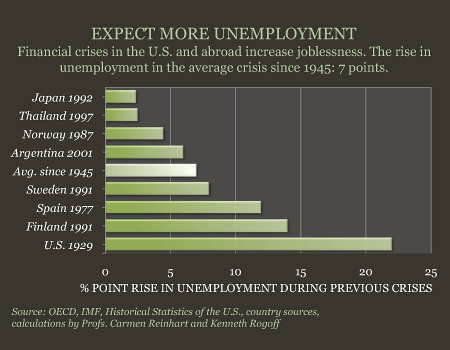How is this recession different from those of the past?
First, this is not just a downturn. This is a downturn following a financial
crisis that doesn’t follow the National Bureau of Economic Research’s
usual business-cycle patterns. Since World War II, the longest recession we’ve
experienced, according to the NBER, was about a year and a half, and on
average, recessions have lasted less than a year. That doesn’t
compare to our current situation, which started more than a year ago and won’t
be over by the end of the year.
Secondly,
this is global. In other circumstances where domestic conditions were bleak,
some countries in recession and experiencing currency depreciation —
like we are — have been able to bolster economic activity
through greater exports. Of course, with the rest of the world mired in
recession, well, we’re not going to grow our way out through exports.
What can we learn from past government responses?
Both positive and negative lessons: what to do
and what not to do. For example, the regions that have worked their way out of
a crisis more quickly — like the Nordic countries in the late ‘80s
and early ‘90s — did so by having the government step in
and take over bad assets.
What
I would stress on our not-to-do list is delay. When it comes to what needs to
be done right now — cleaning up banks’ balance sheets and
clearing out defaulted debts — there’s been quite a bit of
foot-dragging. After all, this crisis started in the summer of 2007.
But
at least we’re past the first of two classic denial phases, which is
denying we have a problem at all. For a long time, this downturn was seen as
primarily a liquidity crisis rather than a solvency crisis. While a liquidity
problem can usually be solved by a temporary injection of cash, a solvency
problem requires banks to come to terms with the fact that some of the loans
they made are never going to be paid back; the banks and some equity holders
will take a loss. That’s where we are right now.
What about the second denial phase?
We’re in the thick of it, which is
recognizing that the government is going to have to step in big. Treasury
Secretary Timothy Geithner’s plan is still vague. And it’s
relying on the private sector to do things like put in fresh capital and buy
some of the banks’ bad assets, things that I doubt it will be able to
do under current conditions. Right now, the government is still betting on that
solution, waiting for something or someone to materialize, and I’m
not very hopeful about it.
What else does the government need to do?
I think the dreaded N-word —
nationalization — of banks will be necessary. That doesn’t
mean turning us into a centrally planned economy in which the government runs
the banks. We’re talking about it having to step in and buy, on a
grand scale, bad assets whether it knows the right price or not. One undeniable
fact is that we don’t have a market price for these bad assets. We
don’t have any signal of what the right price is, and so we’re
hearing concerns about both paying too much and paying too little for those bad
assets. That means the government is going to have to make some pretty bold
assumptions about their value and we’re going to have to live with
some pricing mistakes. However, we can’t keep postponing it; it’s
not likely that we’ll have any more clue two or six months from now
as to what the value of these assets are. The sooner the government buys up
some of these bad assets, the better off we will be.
Will the stimulus package help speed our recovery?
The stimulus is going in the right direction.
However, the real crux of the problem is restoring normalcy to the financial
industry. The financial sector is no longer functioning properly and
facilitating credit to the economy at large. Until normal lending practices are
restored, dealing with things like infrastructure or spending on research is
second order. It’s like dealing with the symptoms rather than the
cause of the problem.
Where can we expect unemployment rates to go from here?
In past financial crises like these, the
unemployment rate has gone up about 7 percentage points from peak to bottom. If
that’s the case and unemployment in the United States bottomed around
4 percent and 4.5 percent in 2006, well, we’re talking about 11
percent to 12 percent if the averages are any kind of indication.
Your research shows that the stock market should start rebounding at the end of 2010. What will happen until then?
I think the best way to describe the imminent
future is volatility. There will be overreaction, and we’ll see ups
and downs without necessarily seeing a clear-cut turning point. Right now there’s
nothing that resembles normalcy in lending practices. Until that is settled, it’s
going to be difficult to see that any upturn in equity markets is a sustained
one. That’s not to say that we won’t have false starts. But
in terms of a sustained turnaround, we’re not there yet.
What’s your best guess as to how this will all play out?
When we look at the post-World War II experience
with financial crises, we’re looking at individual crises or, at
most, regional crises. This is the first time that a crisis is global. It means
that the purchasing power of countries is shrinking very, very quickly. So the
big question mark is just how much worse in terms of duration and depth is this
going to get? The fact that this isn’t just a local disaster makes us
cautious about saying that the recession will be done by 2010.

